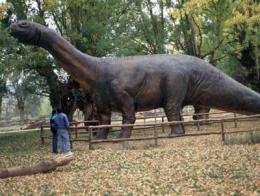The first dinosaur discovered in Spain is younger than originally thought

The research group from Aragon that has the same name as the first Aragosaurus ischiaticus dinosaur discovered 25 years ago in Teruel reveals that it is 15 million years younger than originally believed. Its new dating now means that it was the ancestor of the Titanosauriforms, which includes the biggest dinosaurs.
The Aragosaurus was the first sauropod dinosaur described in Spain some 25 years ago in Galve (Teruel), but its age was never clear. And now it has been discovered that it is 15 million years younger than previously thought. This would make it the only dinosaur of the Hauterivian age (between 136 and 130 million years ago) to be found in Spain.
"This is the only dinosaur of this period found in Spain and is also the most intact in Europe. It can be categorised amongst the well known sauropods of the Jurassic-Cretaceous transition (135 million years ago), the most abundant species during the Barremian age (116 million years ago). As this group has been studied the least, the Aragosaurus fills the gap," explains to SINC José Ignacio Canudo, lead author of the study and researcher in the University of Zaragoza's Aragosaurus-IUCA Group, which stands for the Aragon Research Institute of Environmental Sciences.
Its new age means that Aragosaurus fills in the transitional period between the Jurassic and Cretaceous periods, of which there is little record in the world. Canudo points out that "Aragosaurus would have therefore been a primitive ancestor of the titanosauraus sauropods that would later dominate Europe and Asia during the Late Cretaceous Period."
Published in Geological Magazine, thanks to this new dating the study shows that Aragosaurus, found by José Luis Sanz and his team in 1987, is the oldest of its kind and could even be a common ancestor. The researcher declares that "the group could have originated in Europe, or even in Iberia, but there is still a lot more to be found out."
The new finding also reveals that in the Early Cretaceous Period (135 million years ago), what we now know as the European Continent was made up of a series of large islands that could have been "the point of origin for many vertebrate groups including sauropod dinosaurs like the Basal Titanosauriform."
Fossil dating: An "almost" impossible mission
In order to situate the dinosaurs on their corresponding branch of the evolutionary tree, their remains require dating. In some cases though, this is lacking. Dating dinosaur remains can be problematic due the little information available on the age of the sediments where the fossils lie.
In relation to Aragosaurus ischiaticus "there are some lagoons that allude to its stratigraphic position," outlines Candudo, adding that dating "can often be complicated due to imprecision in continental scales." For this reason, the age of some dinosaur species can vary "even by tens of millions of years", assures the geologist.
The research group carried out their detailed geological field work to find the remains in the lower part of the Castellar Formation site in Teruel. As the lower part is "not as rich" in fossils compared to the upper part, the only Aragosaurus remains that could be dated were a pollen fossil assemblage.
In Canudo's opinion, specifying the age of dinosaurs is "fundamental" in determining the paleobiogeography and evolution of these beings. As the scientist concludes, "incorrect aging provides the wrong results when determining the correlation between continents."
More information: Canudo, J. I.; Gasca, J. M.; Moreno-Azanza, M.; Aurell, M. "New information about the stratigraphic position and age of the sauropod Aragosaurus ischiaticus from the Early Cretaceous of the Iberian Peninsula" Geological Magazine 149(2): 252-263, March 2012 DOI: 10.1017/S0016756811000732
Provided by FECYT - Spanish Foundation for Science and Technology




















